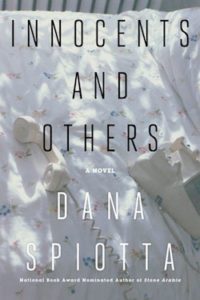
Like a conventional coming-of-age novel, Dana Spiotta’s Innocents and Others opens with an essay looking back on the summer after high school. Unlike a more conventional coming-of-age novel, the narrator—a celebrated documentarian named Meadow Mori—recounts how she lived, studied movies, and slept with an unnamed aging film legend.
With her elegant prose, Spiotta can strike different chords with a single description. Mori tells her parents she wants to join a film collective.
I was thinking of the great director Nicholas Ray and the weird upstate New York collective he formed with his students in the ’70s after he had been forgotten by Hollywood. I have always been attracted to afterlives, discursive asides, and especially misdirection. Note this. I had never seen the film Nicholas Ray made with his students, but it was legendary, at least to me.
It’s wonderful character work that seems, at first, like breezy interior monologue. “Great director” is appended to Nicholas Ray’s name like a beatific title, which captures Mori’s youthful fetish for mystique. “After he had been forgotten by Hollywood” manages to reverse the judgment; “Hollywood” fails by misplacing or not appreciating a “great director.” When the great director’s name is repeated, it’s repeated in full, “Nicholas Ray,” as if in bold print. “Note this” might seem to refer to the line it precedes, but we learn that it applies more accurately to the line it follows. The last line captures the ironic superfluity of the actual artistic artifact (“I had never seen the film”) as well as the longing of teenage ambition and the naïve belief that we are being privately addressed by our favorite artists: “legendary, at least to me.”
The fictionalized essay is published online, with appropriately snarky comments. In a later twist—remember Mori’s attraction to “misdirection”—the essay turns out to be a feint, a provocation on how ductile identity can be. Eventually, Mori moves to New York and makes experimental films about trains with her high school friend, Wexler. She works on a documentary about Kent State, which is nominated for an Academy Award. Another documentary wins festival prizes. But we know from the beginning of the novel that Mori hasn’t completed a film since 2001.
In another thread of the novel, “phone phreaks” are calling powerful figures in Hollywood in the 1980s. These chats are one-sided—the caller is anonymous but the person being called isn’t. Paradoxically, these conversations have material intimacy.
He had taken to sending her VHS cassettes in the mail along with letters and other little gifts. She gave him her Syracuse address, and if he got the impression she was a graduate student at Syracuse University, it wasn’t from anything she directly said. She left gaps, and Jack filled them in. The contours were collaboration, built of his desires and her invitation. She didn’t think of these as lies. He assumed things; she just didn’t correct them. And she did feel like a graduate student.
Jelly, the “phone phreak,” knows that Jack’s assumptions and fantasies will fill the blank spaces, so she withholds information. A confidence game is a collaboration between the deceiver and the deceived. These aren’t lies, but uncorrected assumptions. By the end of the passage, she has slyly inverted the initial thesis: that she has never misidentified herself.
The two threads converge when Mori directs a documentary about Jelly. She convinces Jelly to reconnect with Jack, one of her most frequent interlocutors—and to finally meet him in person. The reversals and betrayals in the last third of the book are perhaps predictable but feel honest, especially if you’ve ever read Janet Malcolm’s maxim: “[Every journalist] is a kind of confidence man, preying on people’s vanity, ignorance, or loneliness, gaining their trust and betraying them without remorse.”
Near the end of Innocents and Others, we read Wexler’s essay, which reads as a foil or a companion to Mori’s. In it, Wexler comes across as gracious, accessible and undefended, opposed to how mythic, obsessive, and difficult Mori is. Wexler praises the high-school teacher who introduces her to filmmaking. She describes her complex friendship with Mori generously.
I saw a comedy that I liked, and I imagined what my version of that would be. A silly teenage comedy with girls as the main characters instead of boys. From a girl’s point of view, but just as raunchy and silly. That seemed radical to me. That’s what I wanted to make. I wanted seduction, not challenge. Or maybe I wanted to smuggle the challenge in a little, not subvert the whole form. Meadow and I were very different, but it was Meadow who made me see that I could—and should—make films. She did it, so I did it.
Wexler hides interesting leaps of imagination or identification with unassuming conjunctions and parallelism (“I saw a comedy that I liked, and I imagined what my version of that would be,” “She did it, so I did it”). The passage ends by shifting the agency in her decision to make films to Mori, the risktaker, the avant-garde artist, but Wexler frames it in an underhanded way: “smuggling the challenge in” is implicitly more difficult than subverting “the whole form.”
Innocents and Others is a wonderfully alive novel about filmmaking, friendship, and self-creation. Its magic lies in the intelligence and depth of its sentences.





